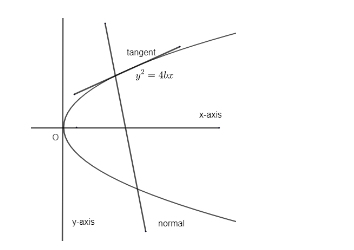
If the normal at the point \[\left( bt_{1}^{2},2b{{t}_{1}} \right)\] on a parabola, \[{{y}^{2}}=4bx\] meets the curve again at point \[\left( bt_{2}^{2},2b{{t}_{2}} \right)\] then,
(a) \[{{t}_{2}}={{t}_{1}}+\dfrac{2}{{{t}_{1}}}\]
(b) \[{{t}_{2}}=-{{t}_{1}}-\dfrac{2}{{{t}_{1}}}\]
(c) \[{{t}_{2}}=-{{t}_{1}}+\dfrac{2}{{{t}_{1}}}\]
(d) \[{{t}_{2}}={{t}_{1}}-\dfrac{2}{{{t}_{1}}}\]
Answer
579.6k+ views
Hint: o solve this question we will first of all determine the equation of normal of given parabola. The equation of normal of parabola of type, \[{{y}^{2}}=4ax\] ar point \[\left( {{x}_{1}},{{y}_{1}} \right)\] is given by,
\[\left( y-{{y}_{1}} \right)=\dfrac{-1}{\dfrac{dy}{dx}}\left( x-{{x}_{1}} \right)\]
Complete step-by-step answer:
Given parabola is, \[{{y}^{2}}=4bx\] this parabola and normal would be of the form.

We have equation of normal of parabola, \[{{y}^{2}}=4ax\] is, \[\left( y-{{y}_{1}} \right)=\dfrac{-1}{\left( \dfrac{dy}{dx} \right)}\left( x-{{x}_{1}} \right)\] at point \[\left( {{x}_{1}},{{y}_{1}} \right)\] - (1)
Given that equation of parabola is, \[{{y}^{2}}=4bx\].
Differentiating both sides with respect to x we get,
\[\begin{align}
& 2y\dfrac{dy}{dx}=4b \\
& \Rightarrow \dfrac{dy}{dx}=\dfrac{4b}{2y} \\
\end{align}\]
Then, \[\dfrac{dy}{dx}=\dfrac{2b}{y}\] - (2)
We are given that the normal is at the point \[\left( bt_{1}^{2},2b{{t}_{1}} \right)\].
Substituting value of \[y=2b{{t}_{1}}\] in equation (2) we get,
\[\Rightarrow \dfrac{dy}{dx}=\dfrac{1\left( 2b \right)}{2b{{t}_{1}}}=\dfrac{1}{{{t}_{1}}}\]
Also the slope of normal is \[\dfrac{-1}{\left( \dfrac{dy}{dx} \right)}\].
\[\Rightarrow \] Slope of normal = \[\dfrac{-1}{\left( \dfrac{1}{{{t}_{1}}} \right)}=-{{t}_{1}}\].
Therefore, equation of normal ar \[\left( bt_{1}^{2},2b{{t}_{1}} \right)\] is,
\[\Rightarrow \left( y-2b{{t}_{1}} \right)=-{{t}_{1}}\left( x-bt_{1}^{2} \right)\] - (3)
Now the point \[\left( bt_{2}^{2},2b{{t}_{2}} \right)\] also lies on the normal. Therefore, point \[\left( bt_{2}^{2},2b{{t}_{2}} \right)\] satisfies (3) we get,
\[\Rightarrow \left( 2b{{t}_{2}}-2b{{t}_{1}} \right)=-{{t}_{1}}\left( bt_{2}^{2}-bt_{1}^{2} \right)\]
Taking 2b common on left we get, and also taking b common on right;
\[\Rightarrow 2b\left( {{t}_{2}}-{{t}_{1}} \right)=-{{t}_{1}}b\left( t_{2}^{2}-t_{1}^{2} \right)\]
Now applying identity \[\left( {{a}_{2}}-{{a}_{1}} \right)\left( {{a}_{2}}+{{a}_{1}} \right)=a_{2}^{2}-a_{1}^{2}\] on the RHS of above equation we get,
\[\Rightarrow 2b\left( {{t}_{2}}-{{t}_{1}} \right)=-{{t}_{1}}b\left( {{t}_{2}}-{{t}_{1}} \right)\left( {{t}_{2}}+{{t}_{1}} \right)\]
Now cancelling \[b\left( {{t}_{2}}-{{t}_{1}} \right)\] on both sides we get,
This can be done as \[b\ne 0\] & \[{{t}_{2}}-{{t}_{1}}\ne 0\].
\[\begin{align}
& \Rightarrow 2=-{{t}_{1}}\left( {{t}_{2}}+{{t}_{1}} \right) \\
& \Rightarrow -{{t}_{1}}\left( {{t}_{2}}+{{t}_{1}} \right)=2 \\
& \Rightarrow -{{t}_{2}}{{t}_{1}}=2+t_{1}^{2} \\
\end{align}\]
Dividing by \[{{t}_{1}}\] we get,
\[\Rightarrow -{{t}_{2}}=\dfrac{2+t_{1}^{2}}{{{t}_{1}}}\]
Multiplying ‘minus’ both sides we get,
\[\Rightarrow {{t}_{2}}=-\dfrac{2}{{{t}_{1}}}-{{t}_{1}}\]
\[\Rightarrow {{t}_{2}}=-{{t}_{1}}-\dfrac{2}{{{t}_{1}}}\], which is option (b).
So, the correct answer is “Option B”.
Note: The possibility of error in this question can be at a point where students directly substitute value of point \[\left( bt_{2}^{2},2b{{t}_{2}} \right)\] in equation of parabola. This would be wrong because this point \[\left( bt_{2}^{2},2b{{t}_{2}} \right)\] is a point of contact normal of parabola. So, we first need to determine the parabola normal of parabola then we can proceed accordingly.
\[\left( y-{{y}_{1}} \right)=\dfrac{-1}{\dfrac{dy}{dx}}\left( x-{{x}_{1}} \right)\]
Complete step-by-step answer:
Given parabola is, \[{{y}^{2}}=4bx\] this parabola and normal would be of the form.

We have equation of normal of parabola, \[{{y}^{2}}=4ax\] is, \[\left( y-{{y}_{1}} \right)=\dfrac{-1}{\left( \dfrac{dy}{dx} \right)}\left( x-{{x}_{1}} \right)\] at point \[\left( {{x}_{1}},{{y}_{1}} \right)\] - (1)
Given that equation of parabola is, \[{{y}^{2}}=4bx\].
Differentiating both sides with respect to x we get,
\[\begin{align}
& 2y\dfrac{dy}{dx}=4b \\
& \Rightarrow \dfrac{dy}{dx}=\dfrac{4b}{2y} \\
\end{align}\]
Then, \[\dfrac{dy}{dx}=\dfrac{2b}{y}\] - (2)
We are given that the normal is at the point \[\left( bt_{1}^{2},2b{{t}_{1}} \right)\].
Substituting value of \[y=2b{{t}_{1}}\] in equation (2) we get,
\[\Rightarrow \dfrac{dy}{dx}=\dfrac{1\left( 2b \right)}{2b{{t}_{1}}}=\dfrac{1}{{{t}_{1}}}\]
Also the slope of normal is \[\dfrac{-1}{\left( \dfrac{dy}{dx} \right)}\].
\[\Rightarrow \] Slope of normal = \[\dfrac{-1}{\left( \dfrac{1}{{{t}_{1}}} \right)}=-{{t}_{1}}\].
Therefore, equation of normal ar \[\left( bt_{1}^{2},2b{{t}_{1}} \right)\] is,
\[\Rightarrow \left( y-2b{{t}_{1}} \right)=-{{t}_{1}}\left( x-bt_{1}^{2} \right)\] - (3)
Now the point \[\left( bt_{2}^{2},2b{{t}_{2}} \right)\] also lies on the normal. Therefore, point \[\left( bt_{2}^{2},2b{{t}_{2}} \right)\] satisfies (3) we get,
\[\Rightarrow \left( 2b{{t}_{2}}-2b{{t}_{1}} \right)=-{{t}_{1}}\left( bt_{2}^{2}-bt_{1}^{2} \right)\]
Taking 2b common on left we get, and also taking b common on right;
\[\Rightarrow 2b\left( {{t}_{2}}-{{t}_{1}} \right)=-{{t}_{1}}b\left( t_{2}^{2}-t_{1}^{2} \right)\]
Now applying identity \[\left( {{a}_{2}}-{{a}_{1}} \right)\left( {{a}_{2}}+{{a}_{1}} \right)=a_{2}^{2}-a_{1}^{2}\] on the RHS of above equation we get,
\[\Rightarrow 2b\left( {{t}_{2}}-{{t}_{1}} \right)=-{{t}_{1}}b\left( {{t}_{2}}-{{t}_{1}} \right)\left( {{t}_{2}}+{{t}_{1}} \right)\]
Now cancelling \[b\left( {{t}_{2}}-{{t}_{1}} \right)\] on both sides we get,
This can be done as \[b\ne 0\] & \[{{t}_{2}}-{{t}_{1}}\ne 0\].
\[\begin{align}
& \Rightarrow 2=-{{t}_{1}}\left( {{t}_{2}}+{{t}_{1}} \right) \\
& \Rightarrow -{{t}_{1}}\left( {{t}_{2}}+{{t}_{1}} \right)=2 \\
& \Rightarrow -{{t}_{2}}{{t}_{1}}=2+t_{1}^{2} \\
\end{align}\]
Dividing by \[{{t}_{1}}\] we get,
\[\Rightarrow -{{t}_{2}}=\dfrac{2+t_{1}^{2}}{{{t}_{1}}}\]
Multiplying ‘minus’ both sides we get,
\[\Rightarrow {{t}_{2}}=-\dfrac{2}{{{t}_{1}}}-{{t}_{1}}\]
\[\Rightarrow {{t}_{2}}=-{{t}_{1}}-\dfrac{2}{{{t}_{1}}}\], which is option (b).
So, the correct answer is “Option B”.
Note: The possibility of error in this question can be at a point where students directly substitute value of point \[\left( bt_{2}^{2},2b{{t}_{2}} \right)\] in equation of parabola. This would be wrong because this point \[\left( bt_{2}^{2},2b{{t}_{2}} \right)\] is a point of contact normal of parabola. So, we first need to determine the parabola normal of parabola then we can proceed accordingly.
Recently Updated Pages
A man running at a speed 5 ms is viewed in the side class 12 physics CBSE

The number of solutions in x in 02pi for which sqrt class 12 maths CBSE

State and explain Hardy Weinbergs Principle class 12 biology CBSE

Write any two methods of preparation of phenol Give class 12 chemistry CBSE

Which of the following statements is wrong a Amnion class 12 biology CBSE

Differentiate between action potential and resting class 12 biology CBSE

Trending doubts
What are the major means of transport Explain each class 12 social science CBSE

Which are the Top 10 Largest Countries of the World?

Draw a labelled sketch of the human eye class 12 physics CBSE

How much time does it take to bleed after eating p class 12 biology CBSE

Explain sex determination in humans with line diag class 12 biology CBSE

When was the first election held in India a 194748 class 12 sst CBSE




